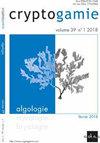Insights into the Rare Mediterranean Endemic Kallymenia spathulata: DNA Phylogenies Resolve This Species as Halymeniaceae (Halymeniales) Rather than Kallymeniaceae (Gigartinales), with the Proposal of Felicinia spathulata comb. nov.
IF 1.5
4区 生物学
Q3 MARINE & FRESHWATER BIOLOGY
引用次数: 2
Abstract
Abstract The rare endemic Mediterranean alga Kallymenia spathulata was collected at Nice and Saint Raphael in June 2013 during a survey conducted along the French Mediterranean coast between Menton and Toulon (French Riviera). DNA barcode sequences (COI-5P) generated from the five collected specimens were identical and allied with Felicinia marginata, another Mediterranean endemic that is classified within the Halymeniaceae (Halymeniales) whereas the genus Kallymenia is representative of the Kallymeniaceae (Gigartinales). We further confirmed the alliance of K. spathulata with Felicinia marginata by conducting phylogenetic analyses inferred by combined genes including Cox1, rbcL and LSU. Unfortunately, none of the specimens were fertile, precluding emending the description of the reproductive anatomy of this species. In light of our phylogenies, we propose the novel combination Felicinia spathulata. The genus Felicinia now comprises two species, both endemic to the Mediterranean Sea.地中海罕见特有种狐獴(Kallymenia spathulata)的认识:DNA系统发育表明该物种为Halymeniaceae (Halymeniales)而非Kallymeniaceae (Gigartinales),并提出Felicinia spathulata comb。11月。
2013年6月,在法国里维埃拉的芒通和土伦之间的法国地中海沿岸,在尼斯和圣拉斐尔采集到罕见的地中海特有藻类Kallymenia spathulata。5个标本的DNA条形码序列(COI-5P)与Felicinia marginata同源,Felicinia marginata属于Halymeniaceae (Halymeniales),而Kallymenia属是Kallymeniaceae (Gigartinales)的代表。通过对Cox1、rbcL和LSU等组合基因进行系统发育分析,进一步证实了spathulata与Felicinia marginata的亲缘关系。不幸的是,没有一个标本是可育的,这就妨碍了对该物种生殖解剖学描述的修改。根据我们的系统发育,我们提出了一种新的组合,即spathulata。Felicinia属现在包括两个物种,都是地中海特有的。
本文章由计算机程序翻译,如有差异,请以英文原文为准。
求助全文
约1分钟内获得全文
求助全文
来源期刊

Cryptogamie Algologie
生物-海洋与淡水生物学
CiteScore
2.60
自引率
7.70%
发文量
11
审稿时长
>12 weeks
期刊介绍:
Cryptogamie is a fast-track and peer-reviewed journal of international scope publishing in English only. It accepts original papers and review articles on the taxonomy, biology and ecology of all cryptogams. An issue of Cryptogamie may be devoted to a single topic, under the responsibility of guest editor(s). All articles published in Cryptogamie are compliant with the different nomenclatural codes. A copyright assignment will be signed by the authors before publication.
Cryptogamie, Algologie accepts articles on systematics as well as ecology and evolution of any kind of algae (including Cyanobacteria).
 求助内容:
求助内容: 应助结果提醒方式:
应助结果提醒方式:


